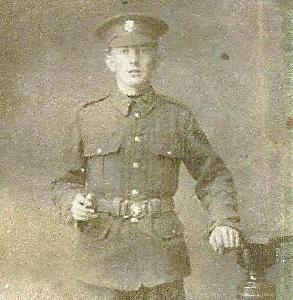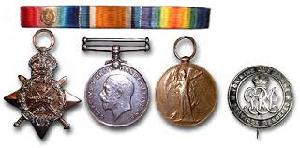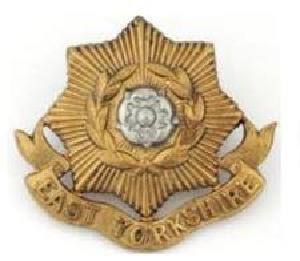
John James Hunter

His service medals

East Yorkshire Regiment badge
Northumberland Fusiliers*
East Yorkshire Regiment
6th (Service) Battalion East Yorkshire Regiment (Pioneers) 1914 – 1917
He enlisted in the Army as a ‘New Army’ volunteer on 27/08/1914: the same day as his brother George and probably all three joined up together (Isaac’s enlistment date is estimated to be November 1914)*
John’s service record is one of those that did not survive the 1940 German air raid over London where the WW1 Army service records were kept, but John’s enlistment date is accurately known from his Silver War Badge roll. However, recruiting for the East Yorkshire Regiment was centred in and around Kingston upon Hull, many miles south of Newcastle. John’s younger brother George joined up in Newcastle only two days later at one of the local Northumberland Regiment recruiting offices. It is therefore surmised that John originally enlisted in the same regiment as his brothers, but during the intervening 12 months, before John embarked as part of reinforcement draft, he appears to have been a mandatory transfer to the 6th (Service) Battalion East Yorkshire Regiment. This theory is supported by the fact that the 6/East Yorks was created for the purpose of being the 11th (Northern) Division’s Pioneer battalion, which required men of certain labour skills, including hard digging and tunnelling experience. Because only the first and subsequent units a soldier served overseas with are shown on a medal index card, this explains why John’s only depicts the East Yorks.
Northumberland Fusiliers* - 14th (Service) Btn (Pioneers) – Supposition:
In August 1914 to mid or late 1915 John would have been posted to one of the “Service” battalions and trained with them somewhere in England. He does not disembark on the Island of Lemnos (Greece) until 7 November 1915, suggesting a departure from the UK about 10 days earlier.
One possibility is the 14th (Service) Battalion N. F. (Pioneers), which was not formed until September 1914, (John enlisted on 27 August 1914 and would start by reporting to the regimental depot) based on miners being selected for Pioneer battalions, but this is just a supposition, no more. The 14/N.F. (P) did not leave for France until September 1915, but if John was with this unit, then he was transferred out probably in August, see below.
01/07/1915: The 6th (Service) Battalion, East Yorkshire Reg’t (Pioneers) sails from Avonmouth to Mudros (Island of Lemnos, the Gallipoli staging area) without John Hunter. This is because John’s disembarkation date on Lemnos is four months later as part of a reinforcement draft. It is safely supposed that John was transferred to the 6/EYR after July 1915.
7 August 1915: the 6/EYR land at Suvla Bay, Gallipoli (Turkey) (John has not arrived yet) as the Pioneer battalion of 11th (Northern) Division (IX Corps) and comes under immense pressure from Turkish attacks that it is required to temporarily revert to its front line infantry role.
7 Aug 1915: 6/EYR is attached to 32nd Brigade for the attack on Turkish machine gun emplacements high up on Chocolate Hill.
8 Aug 1915: Attack on the Turkish defences on Scimitar Hill.
9 Aug 1915: Attack on Tekke Tepe Ridge, all ranks now exhausted and taking heavy casualties from Turk machine guns and artillery well dug in on the higher slopes and 6/EYR was eventually forced to withdrawal back to the beaches by the evening. Casualties of 6/EYR: 26 killed, including the commanding officer, plus 137 wounded and 186 missing or prisoners of the Turks.
21 - 22 Aug 1915: Turkish counter attacks cause further casualties and all of 6/EYR officers are either killed or seriously wounded, plus 22 other ranks killed and 128 wounded and 49 missing. John Hunter fortunately missed all this, but this seems to be the time when the call went back to the East Yorks Reg’t depot in England that the battalion requires to be completely re-built with an order book for at least 600 replacements.
John Hunter is transferred to the East Yorkshire Regiment – 6th East Yorkshire Regiment (Pioneers)
Probably August 1915: John is transferred from the Northumberland Fusiliers to the East Yorkshire Reg’t which is held as reserves at the Regimental Depot to await posting to the 6/EYR as part of a complete battalion replacement draft. The rump of the battalion is already in-theatre on Gallipoli as a disseminated unit licking its wounds and trying to rebuild itself.
GALLIPOLI CAMPAIGN (Oct – Dec 1915)
Approx 22.10.1915: John sails from Britain as part of a reinforcement draft for the 6/EYR on Gallipoli, sailing via Malta, Alexandria (Egypt) to Mudros on the Island of Lemnos for restaging; finally disembarking on Lemnos on 7.11.1915.
7.11.1915 to 4.12.1915: John remains on Lemnos just over 3 weeks to acclimatise, sort himself out and provide work duty on Lemnos until a large enough new draft is ready to be sent out to Sulva Bay Gallipoli.
05/12/1915: The 6/EYR war diary records the first incoming draft of reinforcements since the date of John’s arrival on Lemnos (with others unnamed) as follows:- 2/Lts J.T. Oldenshaw and I.G.F. Brown 9/E. Yorks R. arrive with 300 other ranks from Lemnos and all posted to C & D Coys respectively.
December 1915 6/EYR war diary summary says...16th Dec: Began work on communication trench to 29th Divisional lines and at West Point and embarked vessel “Berry” about 8.30pm as part of the British evacuation.17th Dec: Arrived Mudros (Lemnos Is) and camped south of Condia. John had served on Gallipoli for 12 days right at the end of the campaign.
EGYPT – GUARDING THE SUEZ CANAL (March – June 1916)
02/02/1916: 11th (Northern) Division reaches Alexandria in Egypt having rested and then embarked from Lemnos. The Division completed concentration around Sidi Bishr by the 8 Feb 1916.
19/02/1916: 11th Division comes under XV Corps as from the 9 February and is then posted to cover ‘A’ section of the Suez Canal Defences against the spasmodic attacks by the Senussi Tribesmen, who were allies of the Ottoman Empire.
THE WESTERN FRONT (June 1916 – November 1918)
17/06/1916: Instructions are received for the 11th (Northern) Division to embark for France.
03/07/1916: Embarkation from Alexandria completed.
15/07/1916: Concentration completed around Flers, near St. Pol in France and by the 27 July the Division had taken over part of the front line on the Western Front, coming under VI Corps (Third Army).
END BATTLES OF THE SOMME (September 1916)
14 – 28 September: 6/EYR, as the pioneer battalion of 11th Division, was involved in the tail end Somme engagements at Flers-Courcelette and Thiepval Ridge. (II Corps, Reserve Army).
ANCRE, MESSINES and YPRES (January – October 1917)
January – June 1917: Battle of Messines (IX Corps, Second Army)
Augst – October 1917: Battles of Ypres: including Langemark (Aug) Polygon Wood (Sep-Oct) and Broodseinde / Poelcappelle (Oct). (XVIII Corps, Fifth Army).At some point during the above battles John was medically categorised B1 for return home for discharge, not wounded, but probably worn out.
16/10/1917: John Hunter is discharged in England and awarded the Silver War Badge no- 257515. After taking leave and recovery it is most probable that he may have been discharged to the Class P Army Reserve (back to coal mining under essential war work) but the file is missing to confirm this.
11/11/1918: The Armistice.
1920-23 Awarded the campaign medals 1915 Star, British War Medal and Victory Medal.
Sources Used to Reconstruct John James Hunter’s WW1 Service Record:
WW1 Campaign Medal Rolls held at TNA in WO 329 and on Naval & Military Press DVD-ROM.
WW1 Soldier’s Medal Index Cards.
Silver War Badge Roll.
James, Brigadier E.A. “British Regiments 1914-1918”; Naval & Military Press reprint 1998 for activity of 12/N.F. from formation to going overseas.
Becke, Major A. F. “Order of Battle of Divisions of the Great War” (Part 3 The New Army Divisions); Naval & Military Press reprint for engagements on the Western Front.
Johnstone family knowledge and photograph.
The detailed military history was provided by a researcher in Australia called Graham L Caldwell and he has to take full credit for this valuable work. Many thanks from our family go to Graham.
John James Hunter married Charlotte McGlen in 1913 and they had six children including Doris Hunter, the mother of Derek Johnstone who has collected this information. John James Hunter’s wife Charlotte died in 1936 following the birth of her daughter Joyce. In 1939, John James Hunter married Minnie Josephine Coates (nee Nordstom) and continued to work in the coal mines up until his death in 1954 when he was living at Bishops Meadow at Bedlington.
John James Hunter’s name appears in the Book of Enlistments page 113

